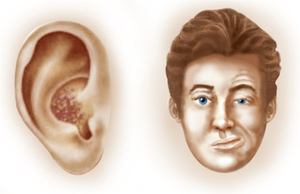Ramsay Hunt syndrome type 2
Ramsay Hunt syndrome type 2, also known as herpes zoster oticus, is a disorder that is caused by the reactivation of varicella zoster virus in the geniculate ganglion, a nerve cell bundle of the facial nerve.[1]
| Ramsay Hunt syndrome (RHS) type 2 | |
|---|---|
| Other names | Herpes zoster oticus |
 | |
| Specialty | Infectious disease |
Ramsay Hunt syndrome type 2 typically presents with inability to move many facial muscles, pain in the ear, taste loss on the front of the tongue, dry eyes and mouth, and a vesicular rash.
Signs and symptoms
Symptoms include acute facial nerve paralysis, pain in the ear, taste loss in the front two-thirds of the tongue, dry mouth and eyes, and an erythematous vesicular rash[2] in the ear canal, the tongue, and/or hard palate.
Since the vestibulocochlear nerve is in proximity to the geniculate ganglion, it may also be affected, and patients may also suffer from tinnitus, hearing loss, and vertigo. Involvement of the trigeminal nerve can cause numbness of the face.
Pathophysiology
Ramsay Hunt syndrome type 2 refers to shingles of the geniculate ganglion. After initial infection, varicella zoster virus lies dormant in nerve cells in the body, where it is kept in check by the immune system. Given the opportunity, for example during an illness that suppresses the immune system, the virus travels to the end of the nerve cell, where it causes the symptoms described above.[2]
The affected ganglion is responsible for the movements of facial muscles, the touch sensation of a part of ear and ear canal, the taste function of the frontal two-thirds of the tongue, and the moisturization of the eyes and the mouth. The syndrome specifically refers to the combination of this entity with weakness of the muscles activated by the facial nerve. In isolation, the latter is called Bell's palsy.[3]
However, as with shingles, the lack of lesions does not definitely exclude the existence of a herpes infection. Even before the eruption of vesicles, varicella zoster virus can be detected from the skin of the ear.[4]
Diagnosis
Ramsay Hunt Syndrome Type 2 can be diagnosed based on clinical features, however, in ambiguous cases PCR or direct immunofluorescent assay of vesicular fluid can help with the diagnosis. Laboratory studies such as WBC count, ERS, and electrolytes should be obtained to distinguish infectious versus inflammatory etiologies.
Clinical diagnosis
On physical exam look for vesicular exanthema on the external auditory canal, concha and or pinna. Dry eyes with possible lower cornea epithelium damage due to incomplete closure of eye lids.
Diagnostic procedures
Ramsay Hunt Syndrome type 2 can usually be diagnosed based on clinical features. However, for suspected cases with unclear presentation, varicella zoster virus can be isolated from vesicle fluid. Tear culture PCR can have positive varicella zoster virus. However 25-35% of patients with Bell palsy can have false positive varicellar zoster virus detected in tears. If central nervous system complications such as meningitis, ventriculitis or meningoencephalitis are suspected, prompt lumbar puncture with spinal fluid analysis and imaging (CT head) are recommended.
Prevention
Shingles is prevented by immunizing against the causal virus, varicella zoster, for example through Zostavax, a stronger version of chickenpox vaccine.
Treatment
Treatment with prednisone and the antiviral drug acyclovir 800mg 5 times a day is controversial, with some studies showing to achieve complete recovery in patients if started within the first three days of facial paralysis,[5] with chances of recovery decreasing as treatment was delayed. Delay of treatment may result in permanent facial nerve paralysis. However, some studies demonstrate that even when steroids are started promptly, only 22% of all patient achieve full recovery of facial paralysis.[6]
Treatment apparently has no effect on the recovery of hearing loss.[7] Diazepam is sometimes used to treat the vertigo.[8]
History
The syndrome is named for James Ramsay Hunt, the eminent neurologist who first described it.[9][10]
References
- Ramsay Hunt, J.R. (1907). "On herpetic inflammations of the geniculate ganglion: a new syndrome and its complications". Journal of Nervous and Mental Disease. 34 (2): 73–96. doi:10.1097/00005053-190702000-00001.
- Sweeney, C.J.; Gilden, D.H. (August 2001). "Ramsay Hunt syndrome". Journal of Neurology, Neurosurgery, and Psychiatry. 71 (2): 149–54. doi:10.1136/jnnp.71.2.149. PMC 1737523. PMID 11459884.
- Kim, In Sup; Shin, Seung-Ho; Kim, Jinn; Lee, Won-Sang; Lee, Ho-Ki (2007). "Correlation between MRI and Operative Findings in Bell's Palsy and Ramsay Hunt Syndrome". Yonsei Medical Journal. 48 (6): 963–968. doi:10.3349/ymj.2007.48.6.963. PMC 2628199. PMID 18159587.
- Murakami, S.; Honda, N.; Mizobuchi, M.; Nakashiro, Y.; Hato, N.; Gyo, K. (1998). "Rapid diagnosis of varicella zoster virus infection in acute facial palsy". Neurology. 51 (4): 1202–1205. doi:10.1212/wnl.51.4.1202. PMID 9781562.
- Murakami, Shingo; Hato, Naohito; Horiuchi, Joji; Honda, Nobumitsu; Gyo, Kiyofumi; Yanagihara, Naoaki (1 March 1997). "Treatment of Ramsay Hunt syndrome with acyclovir-prednisone: Significance of early diagnosis and treatment". Annals of Neurology. 41 (3): 353–357. doi:10.1002/ana.410410310. PMID 9066356.
- Finsterer, Josef (2008). "Management of peripheral facial nerve palsy". European Archives of Oto-Rhino-Laryngology. 265 (7): 743–752. doi:10.1007/s00405-008-0646-4. PMC 2440925. PMID 18368417.
- Kim, Y.H.; Chang, M.Y.; Jung, H.H.; Park, Y.S.; Lee, S.H.; Lee, J.H.; Oh, S.H.; Chang, S.O.; Koo, J.W. (2010). "Prognosis of Ramsay Hunt syndrome presenting as cranial polyneuropathy". Laryngoscope. 120 (11): 2270–2276. doi:10.1002/lary.21108. PMID 20824789.
- NINDS Herpes Zoster Oticus Information Page at NINDS
- synd/2246 at Who Named It?
- "The Ramsay Hunt syndrome". Proceedings of the Royal Society of Medicine. 47 (5): 371–384. May 1954. PMC 1918846. PMID 13167057.
External links
| Classification | |
|---|---|
| External resources |
- NINDS Herpes Zoster Oticus Information Page National Institute of Neurological Disorders and Stroke
- Vaccine at Centers for Disease Control and Prevention